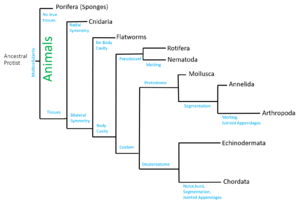Invertebrates
Invertebrates are any animal that does not have a spinal column. They comprise the vast majority (almost 97%) of all animal species and range from insects to crustaceans to worms to coral.[1] On a phylogenetic tree, invertebrates include all animals that do not fall in the subphylum Vertebrata. Although the term "invertebrates" does not define a specific phylum or subphylum like Vertebrata (vertebrates) does, the term has persisted out of convenience and and is used to describe any animal that is not a vertebrate.[2]

Phyla
The main groups of invertebrates within soil are flatworms (Platyhelminthes), snails and slugs (Mollusca), worms (Annelida), nematodes (Nematoda), and arthropods (Arthropoda).[3]
Flatworms are most diverse in tropical regions and are usually found under rocks or in leaf litter where conditions are humid and moist. They are predators and typically eat other invertebrates, including arthropods, earthworms, snails, and slugs. Invasive flatworms can have a damaging effect on an ecosystem since they consume native species. This is especially concerning when native earthworm populations are affected, as earthworms are important soil fauna. Flatworms [4]
Snails and slugs are typically found in leaf litter in forests, but can also be found in gardens, fields, river banks, and urban areas. Most are considered decomposers and feed on plants, fungi, and algae, but can also consume empty shells, scat, and decaying animals. Some species are carnivorous and will eat nematodes and other snails and slugs. They are also important sources of food for many predators such as beetles, millipedes, small mammals, reptiles, and birds. Snails are important for calcium cycling as they uptake calcium from their food and use it to create their shells, and then are eaten by predators. Calcium availability, soil moisture, and land use strongly affect snail populations.[5]
Although annelids include leeches and ragworms, the most ecologically important type that occurs in soil are earthworms. Earthworms decompose dead organic matter and are major drivers of nutrient and water cycling, plant growth, and changes to soil structure. Some species live at the very surface of soil and within leaf litter, while others live in the upper layer of the soil. Some types are deep burrowers and create permanent burrows several meters long that they use to pull organic matter from the surface down into the soil. Earthworms also consume fungi and bacteria, and are commonly preyed upon by mammals and birds. Since earthworms majorly affect organic matter and microbial populations in soil, they indirectly influence the amount and distribution of other soil fauna. Invasive earthworms can also be extremely damaging to ecosystems.[6]
Nematodes are small, non-segmented worms that are found in forest, grassland, and agricultural soils. Food sources differ between species, with some nematodes feeding on fungi, others on bacteria, and some on protozoa or other nematodes. They are typically found where their food sources are concentrated. Nematodes are preyed upon by insects and predatory nematodes, and are parasitized by bacteria and fungi. A few species cause diseases in plants, but beneficial nematodes are important for nutrient cycling and dispersing microbes within the soil.
Arthropods
References
- ↑ Center for Biological Diversity. Invertebrates. https://www.biologicaldiversity.org/species/invertebrates/
- ↑ Louis Aggassiz. (2013). Essay on Classification. Courier Corporation. ISBN 978-0-486-15135-9.
- ↑ Georgia Tech. (2019). Animals: Invertebrates. https://organismalbio.biosci.gatech.edu/biodiversity/animals-invertebrates-2019/
- ↑ Bertone, M., Crawley, S., & Waldvogel, M. (2020). Terrestrial Flatworms, Land Planarians & Hammerhead Worms. https://content.ces.ncsu.edu/terrestrial-flatwormshammerhead-worms
- ↑ Hotopp, K. (2005). Land Snail Ecology. https://www.carnegiemnh.org/science/mollusks/landsnailecology.html
- ↑ Edwards, C. The Living Soil: Earthworms. Natural Resources Conservation Service. https://www.nrcs.usda.gov/wps/portal/nrcs/detailfull/soils/health/biology/?cid=nrcs142p2_053863